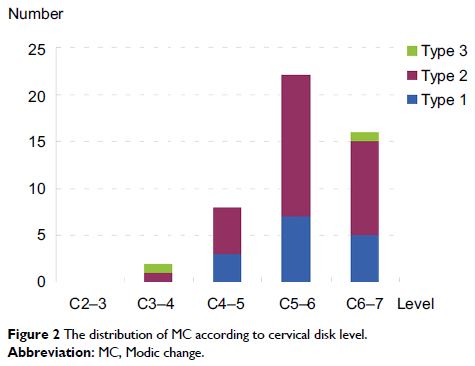108985
论文已发表
注册即可获取德孚的最新动态
IF 收录期刊
- 3.4 Breast Cancer (Dove Med Press)
- 3.2 Clin Epidemiol
- 2.6 Cancer Manag Res
- 2.9 Infect Drug Resist
- 3.7 Clin Interv Aging
- 5.1 Drug Des Dev Ther
- 3.1 Int J Chronic Obstr
- 6.6 Int J Nanomed
- 2.6 Int J Women's Health
- 2.9 Neuropsych Dis Treat
- 2.8 OncoTargets Ther
- 2.0 Patient Prefer Adher
- 2.2 Ther Clin Risk Manag
- 2.5 J Pain Res
- 3.0 Diabet Metab Synd Ob
- 3.2 Psychol Res Behav Ma
- 3.4 Nat Sci Sleep
- 1.8 Pharmgenomics Pers Med
- 2.0 Risk Manag Healthc Policy
- 4.1 J Inflamm Res
- 2.0 Int J Gen Med
- 3.4 J Hepatocell Carcinoma
- 3.0 J Asthma Allergy
- 2.2 Clin Cosmet Investig Dermatol
- 2.4 J Multidiscip Healthc

症状性颈椎病患者 Modic 改变的患病率和危险因素:一个观察性研究
Authors Bai J, Yu K, Sun Y, Kong L, Shen Y
Received 15 September 2017
Accepted for publication 27 December 2017
Published 14 February 2018 Volume 2018:11 Pages 355—360
DOI https://doi.org/10.2147/JPR.S151795
Checked for plagiarism Yes
Review by Single-blind
Peer reviewers approved by Dr Minal Joshi
Peer reviewer comments 2
Editor who approved publication: Dr Michael Schatman
Background: The aim of this study was to assess the prevalence of cervical Modic
change (MC) in patients with cervical spondylosis and to develop a better
understanding of the possible risk factors for the prevalence of MC.
Methods: Between January 2014 and April 2017, patients
with cervical spondylosis were included in our study. All patients underwent
magnetic resonance imaging (MRI) to evaluate the presence of MC. The MC was
classified into three types according to the Modic classification. Potential
risk factors were collected from demographic data, lifestyle variables,
laboratory tests, and radiographic images. Both univariate and multivariate
analysis were used to detect factors associated with MC. We further compared
several variables related to fat metabolism between patients with Type 1 and
Type 2 MC.
Results: The prevalence of MC in patients with cervical
spondylosis was 9.24%. The MC was most frequent at C5–6, followed by C6–7,
C4–5, and C3–4. The proportion of Type 1 MC in patients with neck pain was
significantly higher than that in patients without neck pain (46.2% vs
13.6%, P =0.027). However, none of the
variables associated with fat metabolism showed a significant difference
between Type 1 and Type 2 MC. Multivariate logistic analysis showed that age
≥55 years (odds ratio [OR], 1.91; 95% confidence interval [CI], 1.22–2.98) and
body mass index (BMI) ≥25 kg/m2 (OR, 2.41;
95% CI, 1.62–3.59) were two significant independent factors that are associated
with cervical MC in patients with cervical spondylosis (P <0.05).
Conclusion: It appears that advanced age and high BMI were
two factors that may be responsible for cervical MC. Type 1 MC is associated
with the prevalence of neck pain. However, we cannot confirm that Type 2 MC is
correlated with fat metabolism.
Keywords: Modic change,
cervical spine, cervical spondylosis, risk factor, multivariable analysis
